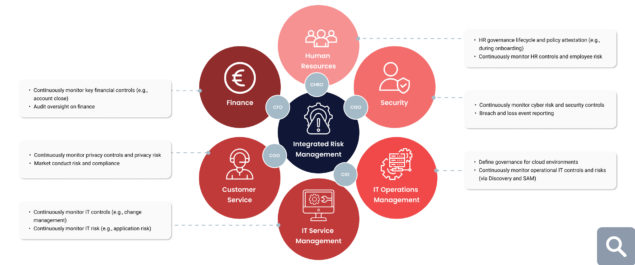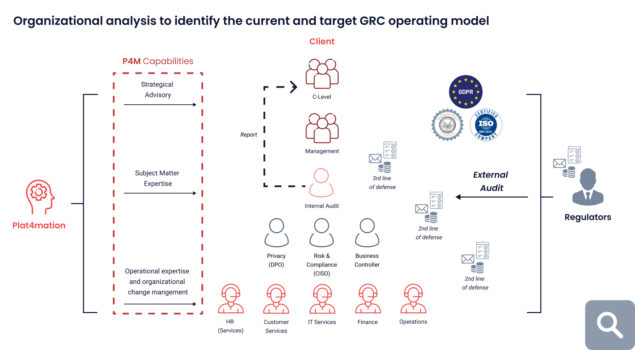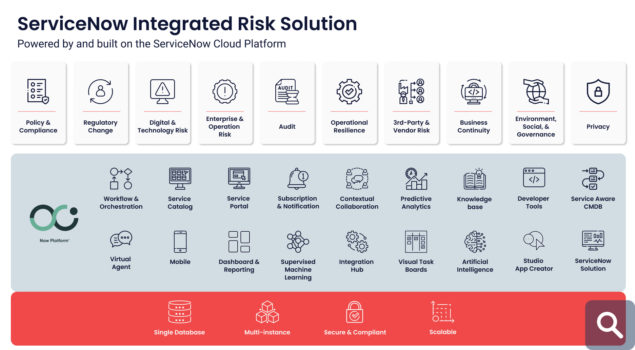Everything you need to know about ServiceNow IRM (Integrated Risk Management)
Quickly jump to:
- What is IRM?
- What is ServiceNow IRM?
- Why do you need ServiceNow IRM?
- Who is ServiceNow IRM for?
- What are the advantages of ServiceNow IRM?
- What are the ServiceNow IRM modules?
- What are typical ServiceNow IRM use cases?
- How do you implement ServiceNow IRM in your organization?
- ServiceNow IRM according to Forrester
- Frequently Asked Questions about ServiceNow IRM
What is IRM?
Integrated Risk Management (IRM) provides organizations with an end-to-end integrated enterprise toolset, to improve risk visibility and align risk and compliance efforts to business priorities and objectives.
ServiceNow IRM supports a broad portfolio of standard functionalities and workflows for managing all organization risk domains, such as reputational risk, strategic risk, operational risk, compliance risk and financial risk.
Using key risk indicators across your organization, whatever the department and at whatever level, IRM enables you to deliver forward-looking insights to help your organization act proactively and make risk-based informed decisions at an executive level.
What is ServiceNow IRM?
ServiceNow IRM is all about managing risk and ensuring compliance throughout your operations. While companies without an integrated view of potential risks struggle to assess their priorities in terms of risk remediation and control – or how changes to compliance obligations impact their business – ServiceNow IRM transforms manual, siloed and inefficient processes into one, real-time integrated view of risk across the enterprise.
ServiceNow IRM simplifies multi-disciplinary and cross-functional integration, processes and communication, within a common repository for all systems, people and applications. This foundational organizational model allows the ability to quickly operationalize and automate risk and control frameworks, which in turn cuts back compliance complexity and testing, and drives down overall compliance burden.
As integrated risk solution, ServiceNow IRM enables you to manage risk right across the enterprise. Automation and continuous monitoring ensure a real-time view of compliance and risk, for informed decision making and increased performance.
Operating controls across multiple regulatory authorities or frameworks – such as (J) SOX, HIPAA, GDPR, PCI and ISO/IEC 27001, SSAE16, ISAE3402 – involves many common, repeated actions. Treating each regulation or framework as an independent set of controls, requires you to perform multiple audits, redundant tests, and repetitive evidence gathering activities.In fact, such separate controls equal much redundant work and needless auditing fees.With ServiceNow IRM you increase efficiency and cut costs by having in place a single consolidated set of controls. By simply cross-mapping controls, you can test a shared control and demonstrate that it meets the requirements across multiple regulatory and best practice frameworks.
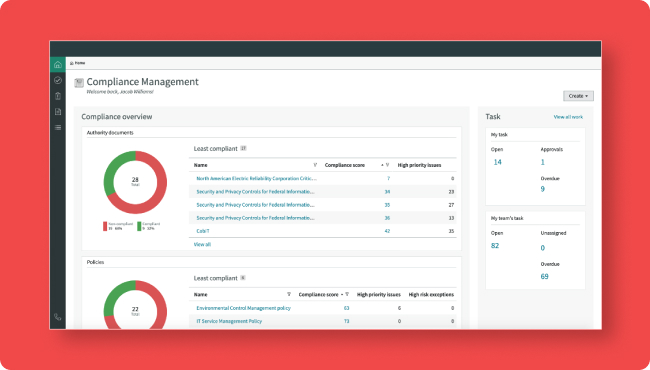
Why do you need ServiceNow IRM?
Improving resilience and preparing for disruption is key for organizations to stay in business. Robust risk and compliance framework managed with ServiceNow IRM provide you better risk visibility, aligns IRM efforts to your business priorities and delivers forward looking insights, so that you can react quickly and appropriately.
Because all kinds of process and asset data are aggregated on the ServiceNow platform, ServiceNow IRM offers a truly enterprise-wide integrated risk solution. For instance, a GDPR violation within Customer Services could result in a legal issue. Similarly, vendor quality issues could impact your business continuity. In order to identify, prioritize and address such issues before they escalate and become business risks, requires you to have risk and compliance embedded in cross-functional workflows. Risk management, cyber security and privacy by design.
With ServiceNow IRM you can:
- End-to-end risk identification and remediation lifecycles
- Manage risk at all levels in your organization
- Get full and real-time insight into risk
- Make risk-based informed decisions at an executive level
- Create a risk-aware culture and be able to make risk-based informed decisions
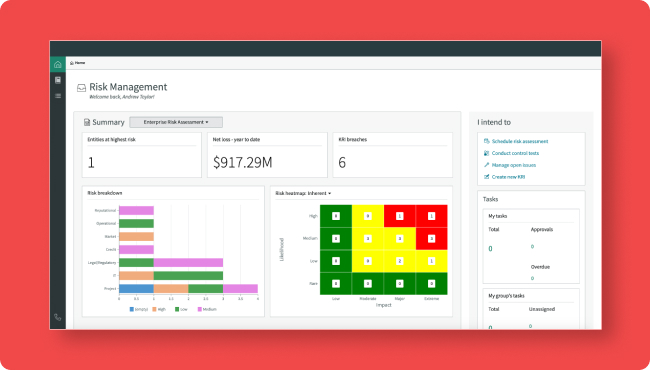
Who is ServiceNow IRM for?
Risk management is something that needs to be done by all businesses. Whatever the industry or size.
ServiceNow IRM is for all enterprises that have a need to mature their GRC function to a truly integrated risk program which helps to identify inefficient processes, human error and unforeseen happenings. The cloud-based ServiceNow platform continuously monitors activities, improves decision making and increases performance through automation and AI-powered experiences. It enables you to collaborate and get the right information to the right people to anticipate, identify, prioritize and respond to risks.
Covering all aspects of governance, risk and compliance throughout your organization, ServiceNow IRM helps you easily manage risk across your operations, so that your business stays in business.
What are the advantages of ServiceNow IRM?
The biggest advantage of ServiceNow IRM is that it enables you to create value in terms of control and speed, while significantly cutting back the costs of compliance. This is achieved by creating streamlined, automated processes between key organizational areas of governance, including HR, IT and Finance. While integrating compliance, risk, internal and external audit functions in a single platform.
With ServiceNow IRM, all governance, risk and compliance management activities are brought together in a single window dashboard that gives full visibility on real-time compliance, risk and control management.

○ Maximize risk resiliency – by boosting visibility into risk and compliance efforts
Streamlined, automated, cross-functional workflows and artificial intelligence based on your central data repository (CMDB), simplify and empower decision-making processes across your business and are less error prone.
Align resilience initiatives across your organization and avoid the delays and costs of organizational and data silos. Effectively share the insights required to protect customer, employees, products and services, with dynamic dashboards that integrate risk and resilience information.
○ Identify risks real time – respond quickly to business and regulatory change
Minimize the threat of business disruption and know where there is a high-risk area, the risk of non-compliance or a change in vendor status. Continuous and automated risk and compliance monitoring give you real-time visibility into critical vulnerabilities and help you identify and assess the potential business impact.
Make more effective decisions for investments, prioritize on risks and safeguard the business environment, based on real-time, organizational-wide insights into risk and compliance status.
○ Cut back on compliance costs and resource requirements
Speed up compliance testing and eliminate the risk of non-compliance with continuous and automated risk and compliance monitoring.
Boost audit assurance, do away with recurring findings and optimize resources around internal audits, using risk data that offers full visibility and traceability. A single system of records and central repository of controls allows a standardized process for efficient, robust and reliable control evidence.
○ Save time and optimize productivity through automation
Save time by automating highly administrative, repetitive, or complex governance, risk and compliance processes, like evidence collection.
Automated workflows help cut back audit costs and minimize errors, while enabling your employees to focus on remediating small risks and stop them from getting bigger. User-friendly interfaces help speed up adoption.
○ Scale with your business
Make your risk management program fully scalable and meet compliance requirements more efficiently by leveraging the OOTB ServiceNow IRM components.

What are the ServiceNow IRM modules?
1 – Policy and Compliance
This module enables you to automate best practice lifecycles and unify compliance processes, to better manage corporate compliance within a centralized process. It is the integration point where internal policies are linked to external regulations and best practices.
ServiceNow Policy and Compliance Management helps you to:
- Reduce risk using real-time insights into compliance, so that you can resolve issues before they turn into real risks.
- Enable automated compliance testing. Replace occasional testing with continuous monitoring. Not only reduce manual work, save time and cut costs, but also identify violations and respond faster.
- Simplify compliance with harmonized test controls across regulations and policies. Access the data from anywhere with mobile interfaces and interactive dashboards.
2 – Regulatory Change
Compliance continues to be a top priority in an extremely complex, ever-changing regulatory landscape. Using manual processes and spreadsheets is no longer an adequate means of keeping abreast of changes.
ServiceNow Regulatory Change provides you the tools to proactively manage regulatory changes and handle risk. Based on a single source of truth, this module integrates seamlessly with regulatory information sources and public RSS feeds. Within a seamless, end-to-end workflow it enables you to assess the impact of changes and monitor implementation efforts across your organization.
ServiceNow Regulatory Change Management helps you to:
- Increase productivity by cutting back on manual processes, and by automating workflows and task management across departments.
- Stay ahead of regulatory change by automatically scanning for any critical changes.
- Improve decision making based on real-time impact assessments.
3 – Risk Management
Managing risk effectively is all about being able to identify, analyze and prioritize high-impact risks. ServiceNow Risk Management enables you to do just that and make informed risk-based decisions.
This module enables you to identify and manage risk in a single place. It identifies non-compliant controls and monitors high-risk areas automatically.
ServiceNow Risk Management enables:
- Better risk reporting with real-time insights provided by role-based dashboards.
- Faster and better decision making based on automated risk scores that also enable prioritization of actions.
- Smarter and quicker issue management by automating workflows across teams and using AI to assign and suggest corrective actions.
4 – 3rd Party and Vendor Risk
As businesses rely more on third parties for products or services, such parties are also increasingly key to business success. At the same time, third party risk and non-compliance can also impact your organization or business continuity.
ServiceNow Vendor Risk Management enables you to automate vendor risk assessments and provides you full transparency into the status of issues. It does away with time-consuming and fault-prone siloed information and manual tracking of third-party risk. Customizable dashboards are based on a common data model that aligns vendor risk management with your risk strategy to create an integrated view of risk.
ServiceNow 3rd Party and Vendor Risk Management helps you to:
- Boost efficiency, productivity and visibility by automating risk assessments. Know which risks need to be tackled with automated tracking of the performance of your vendors.
- Enable collaboration with third-party vendors through automated processes and workflows that also provide vendors visibility into the status of assessments, issues and tasks.
- Integrate your Vendor Risk Management with your organizational-wide risk management strategy.
5 – Audit Management
Audit management is all about ensuring that board-approved audit directives are implemented by all parties involved in the process of compiling audits.
ServiceNow Audit Management enables you to streamline audit processes, scope and prioritize audit management and planning, based on real-time and aggregated risk data. It also helps avoid duplication of work and improves decision making by continuous compliance monitoring.
ServiceNow Audit Management helps you to:
- Streamline all audit processes into an automated audit engagement life cycle.
- Improve audit management and planning with scheduled or automated data findings.
- Enhance audit assurance and help audit managers stay ahead of issues with continuous compliance monitoring.
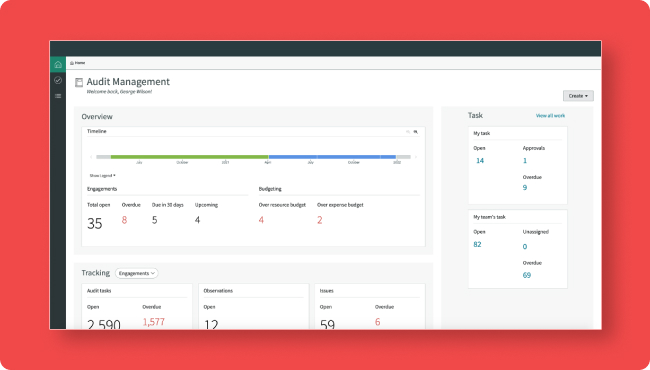
6 – Resilience and Continuity Management
Disruptions in operations are a continual threat to any business. Whether it regards the threat from non-compliant vendors, a hiccup in your IT services or any unforeseen disasters. They all bring with them the risk of bringing your business to a shuddering halt.
ServiceNow Business Continuity Management enables you to define, prepare, test and execute solutions to restore operations in case of an actual crisis or a planned event.
The application finds and prioritizes business services to produce recovery time and point objectives. Using business and operational data from the CMDB, it tracks the lifecycle of plans and ensures they are up to date and accurate.
ServiceNow Resilience and Continuity Management helps you to:
- Prioritize critical functions, find key dependencies, and create plans to protect vital assets.
- Identify and close gaps in continuity plans by running and testing continuity plans.
- Recover more quickly and reduce disaster impacts with continuity plans. Make fast, informed decisions by understanding dependencies.
What are typical ServiceNow IRM use cases?
ServiceNow IRM addresses a wide range of risk, compliance and operational resilience requirements. It offers an integrated approach to managing risk across your enterprise.
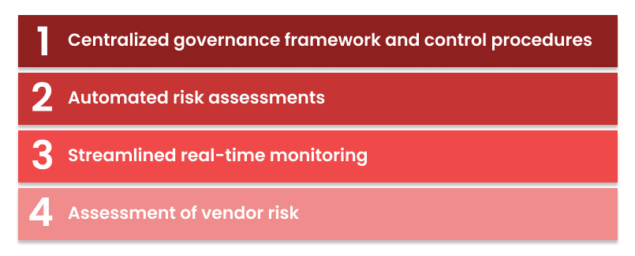
The 4 main use cases for ServiceNow IRM

Centralized governance framework and control procedures
Once defined, repetitive processes can be automated right across functional groups with ServiceNow IRM. Similarly, processes, control procedures and compliance testing can be automated to identify non-compliant controls, respond to issues and adhere to best practices.

Automated risk assessments
Accurately identify, access, monitor and manage risks real time. ServiceNow IRM combines risk methodologies to determine risk scores, based on performance data from a single register (your CMDB).

Streamlined real-time monitoring
Using automated data validation and evidence gathering, ServiceNow IRM identifies non-compliant controls, monitors high-risk areas and manages Key Risk Indicators and Key Performance Indicators. Relationships across entities are shown using CMDB information, thereby enabling real-time business impact assessment of a control failure.

Assessment of vendor risk
Reduce vendor risk by monitoring vendors and track performance over time within a single vendor catalog. Vendor risk is based on risk scores that are generated based on built-in questionnaires, updated in real time in the vendor catalog.
How do you implement ServiceNow IRM in your organization?
Here is our 6-step plan for a smooth implementation of ServiceNow IRM in your organization. It will ensure you deliver efficient and robust corporate compliance and control, while minimizing risk and cost and maximizing organizational adoption.
Our end-to-end vision is based on best practices acquired while supporting customers in adopting ServiceNow IRM and helping them tackle organizational change when implementing ServiceNow modules.
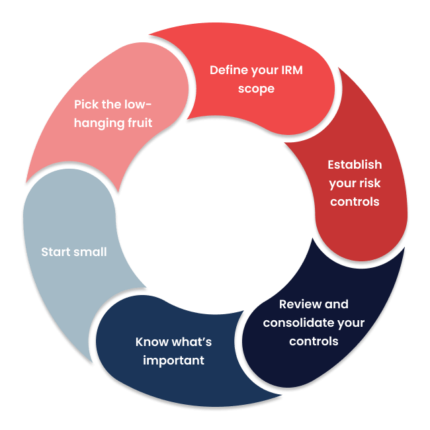
1. Define your IRM scope
Identify the areas of improvement in your current IRM operating model. The first question that should be asked is: Where are you going to use IRM in your organization? That depends on your use case.
2. Establish your risk controls
Know what is needed upfront to manage and control points in your organization and include them in your implementation plan. This should include defining:
- Controls and control owners
- Control tests and expected results
- Test and control frequencies
- Risks, impact, and likelihood
- Critical vendors
- Mapping of policies, procedures, controls, and risks
3. Review and consolidate your controls
Risk management is an ongoing, never-ending process. Regular review of your controls is key to remaining compliant and avoid audit findings, penalties or lose your certification. These are some of the key questions that need to be asked:
- How does this control support your business objectives?
- Is this control preventing or detecting risk? Is there a control that can better protect your business?
- Is there a control that can be put in place that reduces process overhead and improves IT performance while also mitigating risk?
- Can a complicated control be replaced with a simpler, more effective control?
- Can controls be consolidated for a better and less costly approach?
4. Know what’s important
Controls protect organizations from risk. If you fail to define what is important (and what isn’t), controls will get applied to everything, regardless of importance. This means you end up doing redundant work while failing to focus on the real risks that need to be tackled.
Focus on what matters by identifying the risks and their potential business impact.
5. Start small
Minimize business disruption and benefit from incremental technology adoption by starting small with IRM implementation. In addition, through continuous monitoring you can identify and remediate any control deficiencies as they occur.
This means you will be able to identify problems when they’re small and stop them from getting any bigger. By starting small in this way you’ll significantly reduce your overall risk, as well as the level of effort required to remediate issues and maintain compliance.
6. Pick the low-hanging fruit
Next to staring small, it is always advisable to look for the obvious opportunities to reduce risk. For instance, by automating highly administrative processes. Such automation has the immediate benefit of cutting back processing costs.

ServiceNow IRM according to Forrester
ServiceNow commissioned Forrester to conduct a Total Economic Impact™ study and examine the potential return on investment (ROI) enterprises may realize by deploying ServiceNow.
‘To better understand the benefits, costs, and risks associated with this investment, Forrester interviewed five customers with experience using ServiceNow GRC, Vendor Risk Management, and Business Continuity Management.’
‘Prior to investing in ServiceNow, the interviewees said that their organization’s risk management was haphazard, lacked efficient business continuity planning, and compliance management was fragmented, i.e., compliance was done manually across several disparate spreadsheets or through legacy systems with antiquated processes. Managing regulatory and operational risks was difficult, and the issues were further exacerbated by mounting operational compliance requirements and regulatory pressures.’
Prior to ServiceNow, interviewees experienced the following limitations:
- Spotty compliance, due to a lack of a centralized source of information
- Governance, risk, and compliance still very much a manual effort.
- Reporting near impossible with hundreds upon hundreds of spreadsheets.
- Compliance and risk processes used to keep the business upright rather than move it forward.
- Inefficient business continuity planning due to lacking technology.
According to Forrester, ServiceNow solutions helped these customers:
- Automate tasks/workflows and reduce manual oversight.
- Improve the compliance and risk management efficiencies and help scale GRC efforts.
- Consolidate data and link and map information for better impact analysis and business continuity.
- Gain efficiency and better optimize resources with reduction of redundant tasks and improved risk management.
- Accelerate decision-making process with improved integration between risk and compliance.
- Effectively manage third-party risk and disruption with faster vendor assessments enabled by vendor risk management program.
- Develop a more efficient business continuity management program through identification and prioritization of business-critical core processes in the delivery of products and services to its internal and external customers.
- Provides better visibility to executives through more accurate and timely reporting.
Key Findings by Forrester:
The customer interviews revealed the following key quantifiable benefits that add up to a ROI of 235% over 3 years.
- Compliance testing efficiency gains from automation
- Savings from risk management efficiencies
- Audit savings through improved visibility with ServiceNow
- Reduction in cost to assess vendor risk
- Efficiency gain from ServiceNow BCM
- GRC, VRM, and BCM Management Productivity
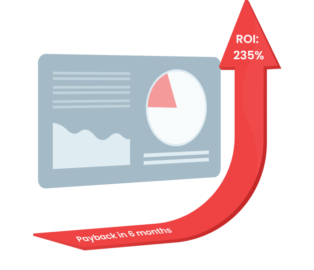
‘With the advent of linked and mapped information, risk analysis and reporting became a much simpler process … transparency and new insights, allowing organizational leaders to improve business decision-making and reduce risk. Reporting could finally be conducted easily without a laborious undertaking of compiling siloed data across hundreds of spreadsheets.’
Frequently Asked Questions about ServiceNow IRM
○ Does ServiceNow IRM support compliancy frameworks such as NIST, SOX, PCI, GDPR or ISO/IEC 27001?
Yes, ServiceNow IRM facilitates risk and compliancy frameworks. Being fully compliant to any one of these frameworks involves more than simply automating one process.
It involves building processes and systems in such a way that you can constantly show that you are compliant. With ServiceNow IRM you get an integrated risk platform that makes it possible to report on compliance at multiple levels throughout the organization based on real-time data. Reporting is done on one single dashboard which shows risks or control failures that need attention in order to be fully compliant.
○ Does my organization need ServiceNow IRM?
Risk awareness is something that varies widely depending not only on the size of your company, but also on the industry. For some, compliancy is a simple matter for which a report based on data from an excel document suffices.
For all other organizations, risk maturity calls for more robust reporting methods that offer constant monitoring of all risk factors throughout the enterprise. ServiceNow IRM brings risk management to a maturity level where pro-active decisions can be made to ensure full compliancy across your operations at all times.
○ What are the benefits of ServiceNow IRM versus a dedicated IRM solution?
Dedicated IRM solutions offer point solutions that fall far short of what can be reached with an enterprise-wide platform such as ServiceNow IRM.
If you already have ServiceNow to optimize your enterprise, you will leverage platform capabilities when you implement ServiceNow IRM.
And if you’re new to ServiceNow: you will experience what it means to work better together when you implement ServiceNow IRM and enable different levels in your organization to land on this enterprise-wide platform. ServiceNow IRM transforms inefficient processes across your organization into an integrated risk program built on a single platform.

○ How is existing software integrated with ServiceNow IRM?
The ServiceNow single and scalable platform offers simple integrations without costly customizations, also through IntegrationHub.
○ Why is risk-based informed decision making so important?
Risk never involves just a single person, department, incident, entity or process. It always concerns the sum of the parts, and how these interact with each other. This makes risk management inherently complex.
To drive down cost of compliance and decrease risk it is essential to have a tool such as ServiceNow IRM offering real-time data that enables risk-based informed decision making.
○ Can we implement ServiceNow IRM without having any ServiceNow modules?
Although most clients that come to us already have ServiceNow, we also regularly implement ServiceNow IRM for clients who are completely new to ServiceNow.
○ How long does it take to implement ServiceNow IRM?
A high-speed IRM pilot to assess the key-capabilities needed and determine more detailed user stories and requirements can be run in 4 weeks. This serves as the foundation for the actual implementation project.
Following on from that, an end-to-end IRM implementation typically takes 6-8 weeks to complete. Depending on the scope and size of the organization, implementation time may vary.
Get in touch with one of our IRM experts
We can’t wait to help make work flow with ServiceNow IRM! Fill out the form below, and we will get you in touch with the right ServiceNow expert.


